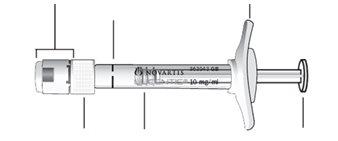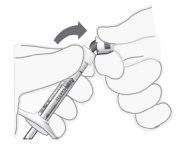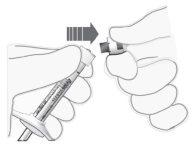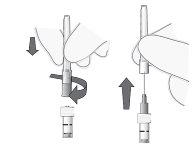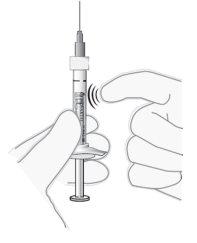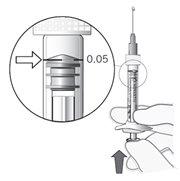

ЛЮЦЕНТИС 10 мг/мл раствор для инъекций в предварительно заполненном шприце


Инструкция по применению ЛЮЦЕНТИС 10 мг/мл раствор для инъекций в предварительно заполненном шприце
Введение
Прошпект:информация для пациента
Лусентис 10мг/мл раствор для инъекций в предварительно заполненном шприце
ранибизумаб
Прочитайте внимательно весь прошпект перед тем, как вам будет введено это лекарство, поскольку он содержит важную информацию для вас.
- Сохраните этот прошпект, поскольку вам может потребоваться прочитать его снова.
- Если у вас есть какие-либо вопросы, проконсультируйтесь с вашим врачом.
- Если вы испытываете побочные эффекты, проконсультируйтесь с вашим врачом, даже если это побочные эффекты, которые не перечислены в этом прошпекте. См. раздел 4.
Содержание прошпекта
- Что такое Лусентис и для чего он используется
- Что вам нужно знать перед тем, как вам будет введен Лусентис
- Как вводится Лусентис
- Возможные побочные эффекты
- Хранение Лусентиса
- Содержание упаковки и дополнительная информация
1. Что такое Лусентис и для чего он используется
Что такое Лусентис
Лусентис - это раствор, который вводится в глаз. Лусентис относится к группе лекарств, называемых антиангиогенезными агентами. Он содержит активное вещество под названием ранибизумаб.
Для чего используется Лусентис
Лусентис используется у взрослых для лечения различных глазных заболеваний, которые вызывают нарушение зрения.
Эти заболевания являются результатом повреждения сетчатки (светочувствительной оболочки в задней части глаза), вызванного:
- Ростом аномальных кровеносных сосудов, которые теряют жидкость. Это наблюдается при таких заболеваниях, как возрастная макулярная дегенерация (ВМД) и пролиферативная диабетическая ретинопатия (ПДР, заболевание, вызванное диабетом). Также может быть связано с хориоидальной неоваскуляризацией (ХНВ) из-за патологической миопии (ПМ), ангиоидных полос, центральной серозной хориоретинопатии или воспалительной ХНВ.
- Макулярным отеком (отеком центра сетчатки). Причина этого отека может быть диабетом (заболевание, известное как диабетический макулярный отек (ДМО)) или блокировкой вен сетчатки глаза (заболевание, известное как окклюзия вены сетчатки (ОВС)).
Как действует Лусентис
Лусентис распознает и специфически связывается с белком под названием фактор роста эндотелия сосудов А (VEGF-A) человека, присутствующим в глазах. В избытке VEGF-A вызывает рост аномальных кровеносных сосудов и отек в глазу, что может привести к нарушению зрения при таких заболеваниях, как ВМД, ДМО, ПДР, ОВС, ПМ и ХНВ. Благодаря связыванию с VEGF-A, Лусентис может предотвратить его действие и предотвратить такой аномальный рост и отек.
При этих заболеваниях Лусентис может помочь стабилизировать и, в многих случаях, улучшить ваше зрение.
2. Что вам нужно знать перед тем, как вам будет введен Лусентис
Вам не должны вводить Лусентис
- Если вы аллергичны к ранибизумабу или любому другому компоненту этого лекарства (перечисленному в разделе 6).
- Если у вас есть инфекция в глазу или вокруг него.
- Если у вас есть боль или покраснение (тяжелое внутриглазное воспаление) в глазу.
Предостережения и меры предосторожности
Проконсультируйтесь с вашим врачом перед тем, как вам будет введен Лусентис
- Лусентис вводится в виде инъекции в глаз. Иногда после лечения Лусентисом может出现 инфекция внутри глаза, боль или покраснение (внутриглазное воспаление), отслойка или разрыв одной из слоев, расположенных в задней части глаза (отслойка или разрыв сетчатки и отслойка или разрыв пигментного эпителия сетчатки), или помутнение хрусталика (катаракта). Важно выявить и лечить такую инфекцию или отслойку сетчатки как можно скорее. Немедленно сообщите вашему врачу, если вы заметите симптомы, такие как боль в глазу или увеличение дискомфорта в глазу, если ухудшается покраснение в глазу, зрение становится нечетким или снижается, увеличивается количество мелких пятен в зрении или увеличивается чувствительность к свету.
- У некоторых пациентов после инъекции давление в глазу может увеличиться в течение короткого периода времени. Возможно, вы не будете осведомлены об этом, поэтому ваш врач может следить за давлением в глазу после каждой инъекции.
- Сообщите вашему врачу, если у вас были какие-либо глазные заболевания или если вы получали лечение для глаз ранее, или если у вас был инсульт или были временные симптомы инсульта (слабость или паралич конечности или лица, трудности с речью или пониманием). Эта информация будет учитываться при оценке того, является ли Лусентис подходящим лечением для вас.
Для получения более подробной информации о возможных побочных эффектах, которые могут возникнуть во время лечения Лусентисом, см. раздел 4 («Возможные побочные эффекты»).
Дети и подростки (моложе 18лет)
Не рекомендуется использовать Лусентис у детей и подростков, поскольку его эффективность и безопасность не установлены в этих возрастных группах.
Другие лекарства и Лусентис
Сообщите вашему врачу, если вы используете, недавно использовали или можете использовать любое другое лекарство.
Беременность и лактация
- Женщины, которые могут стать беременными, должны использовать эффективный метод контрацепции во время лечения и в течение как минимум трех месяцев после последней инъекции Лусентиса.
- Нет опыта использования Лусентиса у беременных женщин. Лусентис не должен использоваться во время беременности, если только потенциальная польза не превышает потенциальный риск для плода. Если вы беременны, думаете, что можете быть беременной или планируете стать беременной, проконсультируйтесь с вашим врачом перед лечением Лусентисом.
- Небольшие количества Лусентиса могут проникать в грудное молоко, поэтому не рекомендуется использовать Лусентис во время лактации. Проконсультируйтесь с вашим врачом или фармацевтом перед лечением Лусентисом.
Вождение и использование машин
После лечения Лусентисом вы можете временно испытывать нечеткое зрение. Если это происходит, не驾те транспортные средства и не используйте машины до тех пор, пока этот симптом не пройдет.
3. Как вводится Лусентис
Лусентис вводится офтальмологом в виде единственной инъекции в глаз под местной анестезией. Обычная доза одной инъекции составляет 0,05 мл (которая содержит 0,5 мг активного вещества). Предварительно заполненный шприц содержит больше количества, чем рекомендуемая доза 0,5 мг. Неинъецируемый объем должен быть удален перед инъекцией. Если вводится весь объем предварительно заполненного шприца, это может привести к передозировке.
Интервал между двумя дозами, введенными в один и тот же глаз, должен быть не менее четырех недель. Все инъекции будут введены офтальмологом.
Для предотвращения инфекции перед инъекцией ваш врач тщательно очистит ваш глаз. Ваш врач также введет местный анестетик, чтобы уменьшить или предотвратить любую боль, которую вы можете испытывать при инъекции.
Лечение начинается с инъекции Лусентиса один раз в месяц. Ваш врач будет контролировать состояние вашего глаза и, в зависимости от того, как вы реагируете на лечение, решит, нужно ли вам дальнейшее лечение и когда вам нужно быть леченым.
В конце прошпекта в разделе «Как приготовить и ввести Лусентис» приведены подробные инструкции по применению.
Пациенты пожилого возраста (65лет и старше)
Лусентис может использоваться у людей в возрасте 65 лет и старше, и не требуется коррекция дозы.
Перед прекращением лечения Лусентисом
Если вы рассматриваете возможность прекращения лечения Лусентисом, посетите следующий прием и обсудите это с вашим врачом заранее. Ваш врач посоветует и решит, как долго вам следует быть леченым Лусентисом.
Если у вас есть какие-либо другие вопросы о использовании этого лекарства, проконсультируйтесь с вашим врачом.
4. Возможные побочные эффекты
Как и все лекарства, это лекарство может вызывать побочные эффекты, хотя не все люди испытывают их.
Побочные эффекты, связанные с введением Лусентиса, могут быть вызваны либо самим лекарством, либо процедурой инъекции, и большинство из них влияют на глаз.
Ниже описаны наиболее серьезные побочные эффекты:
Частые серьезные побочные эффекты(могут возникнуть у до 1 из 10 пациентов): Отслойка или разрыв слоя в внутренней части глаза (отслойка или разрыв сетчатки), что приводит к появлению вспышек света с плавающими частицами, прогрессирующими до временной потери зрения или помутнения хрусталика (катаракты).
Редкие серьезные побочные эффекты(могут возникнуть у до 1 из 100 пациентов): Слепота, инфекция глазного яблока (эндофтальмит) с воспалением внутренней части глаза.
Симптомы, которые вы можете испытывать, включают боль или увеличение дискомфорта в глазу, ухудшение покраснения в глазу, нечеткое зрение или снижение зрения, увеличение количества мелких пятен в зрении или увеличение чувствительности к свету. Сообщите вашему врачу немедленно, если вы испытываете любой из этих побочных эффектов.
Ниже описаны наиболее часто сообщаемые побочные эффекты:
Очень частые побочные эффекты(могут возникнуть у более 1 из 10 пациентов)
Глазные побочные эффекты включают: Воспаление глаза, кровотечение в задней части глаза (геморрагия в сетчатке), нарушения зрения, боль в глазу, мелкие частицы или пятна в зрении (плавающие частицы), кровь в глазу, раздражение глаза, ощущение наличия чего-то внутри глаза, увеличение производства слез, воспаление или инфекция на краю век, сухость глаза, покраснение или зуд в глазу и увеличение давления в глазу.
Неглазные побочные эффекты включают: Боль в горле, заложенность носа, насморк, головная боль и боль в суставах.
Ниже описаны другие побочные эффекты, которые могут возникнуть после лечения Лусентисом:
Частые побочные эффекты
Глазные побочные эффекты включают: Снижение остроты зрения, отек участка глаза (увеа, роговица), воспаление роговицы (передняя часть глаза), мелкие отметины на поверхности глаза, нечеткое зрение, кровотечение в месте инъекции, кровотечение в глазу, выделения из глаза с зудом, покраснением и отеком (конъюнктивит), чувствительность к свету, дискомфорт в глазу, отек век, боль в веке.
Неглазные побочные эффекты включают: Инфекции мочевыводящих путей, низкий уровень красных кровяных телец (с симптомами, такими как усталость, трудности с дыханием, головокружение, бледность), тревога, кашель, тошнота, аллергические реакции, такие как сыпь, крапивница, зуд и покраснение кожи.
Редкие побочные эффекты
Глазные побочные эффекты включают: Воспаление и кровотечение в передней части глаза, скопление гноя в глазу, изменения в центральной части поверхности глаза, боль или раздражение в месте инъекции, необычное ощущение в глазу, раздражение век.
Сообщение о побочных эффектах
Если вы испытываете любой побочный эффект, проконсультируйтесь с вашим врачом, даже если это побочные эффекты, которые не перечислены в этом прошпекте. Вы также можете сообщить о них напрямую через национальную систему уведомления, включенную в Приложение V. Сообщая о побочных эффектах, вы можете внести свой вклад в предоставление более подробной информации о безопасности этого лекарства.
5. Хранение Лусентиса
- Храните это лекарство в недоступном для детей месте.
- Не используйте это лекарство после даты истечения срока годности, указанной на коробке после «CAD» и на этикетке предварительно заполненного шприца после «EXP». Дата истечения срока годности - последний день месяца, указанного.
- Храните в холодильнике (при температуре между 2°C и 8°C). Не замораживайте.
- До использования герметичную упаковку можно хранить при комнатной температуре (25°C) в течение максимум 24 часов.
- Храните предварительно заполненный шприц в герметичной упаковке в коробке, чтобы защитить его от света.
- Не используйте поврежденную упаковку.
6. Содержимое упаковки и дополнительная информация
Состав Люцентиса
- Активное вещество - ранибизумаб. В 1 мл содержится 10 мг ранибизумаба. Предварительно заполненный шприц содержит 0,165 мл, что эквивалентно 1,65 мг ранибизумаба. Это обеспечивает полезное количество, которое обеспечивает единственную дозу 0,05 мл, содержащую 0,5 мг ранибизумаба.
- Другие компоненты - α,α-трегалоза дигидрат; гидрохлорид гистидина моногидрат; гистидин; полисорбат 20; вода для инъекций.
Внешний вид продукта и содержимое упаковки
Люцентис - это инъекционный раствор, содержащийся в предварительно заполненном шприце. Предварительно заполненный шприц содержит 0,165 мл водного стерильного раствора, прозрачного, от бесцветного до светло-желтого цвета. Предварительно заполненный шприц содержит больше, чем рекомендуемая доза 0,5 мг. Извлекаемый объем не будет полностью введен. Избыточный объем должен быть удален перед инъекцией. Если будет введен весь объем предварительно заполненного шприца, это может привести к передозировке.
Упаковка имеет размер предварительно заполненного шприца, упакованного в герметичную контейнерную упаковку. Предварительно заполненный шприц предназначен для одноразового использования.
Владелец разрешения на маркетинг
Novartis Europharm Limited
Виста Билдинг
Элм Парк, Меррион Роуд
Дублин 4
Ирландия
Производитель
Novartis Pharma GmbH
Рунстрассе 25
90429 Нюрнберг
Германия
Novartis Manufacturing NV
Рейксвег 14
2870 Пурс-Синт-Амандс
Бельгия
Novartis Pharma GmbH
Софи Герман Штрассе 10
90443 Нюрнберг
Германия
Вы можете получить больше информации о этом лекарстве, обратившись к местному представителю владельца разрешения на маркетинг:
Бельгия/Белгique/Бельгия Novartis Pharma N.V. Тел: +32 2 246 16 11 | Литва SIA Novartis Baltics Литовское филиал Тел: +370 5 269 16 50 |
Novartis Болгария ЕOOD Тел: +359 2 489 98 28 | Люксембург/Люксбург Novartis Pharma N.V. Тел: +32 2 246 16 11 |
Чешская Республика Novartis s.r.o. Тел: +420 225 775 111 | Венгрия Novartis Венгрия Кфт. Тел: +36 1 457 65 00 |
Дания Novartis Healthcare А/С Тел: +45 39 16 84 00 | Мальта Novartis Pharma Services Inc. Тел: +356 2122 2872 |
Германия Novartis Pharma GmbH Тел: +49 911 273 0 | Нидерланды Novartis Pharma Б.В. Тел: +31 88 04 52 111 |
Эстония SIA Novartis Baltics Эстонское филиал Тел: +372 66 30 810 | Норвегия Novartis Норвегия АС Тел: +47 23 05 20 00 |
Греция Novartis (Эллас) А.Ε.Б.Ε. Тел: +30 210 281 17 12 | Австрия Novartis Pharma GmbH Тел: +43 1 86 6570 |
Испания Novartis Фармацевтика, С.А. Тел: +34 93 306 42 00 | Польша Novartis Польша Сп. з о.о. Тел: +48 22 375 4888 |
Франция Novartis Pharma S.A.S. Тел: +33 1 55 47 66 00 | Португалия Novartis Фарма - Продукты Фармацевтики, С.А. Тел: +351 21 000 8600 |
Хорватия Novartis Хорватия д.о.о. Тел: +385 1 6274 220 | Румыния Novartis Фарма Сервисес Румыния СРЛ Тел: +40 21 31299 01 |
Ирландия Novartis Ирландия Лтд. Тел: +353 1 260 12 55 | Словения Novartis Фарма Сервисес Инк. Тел: +386 1 300 75 50 |
Исландия Вистор хф. Сими: +354 535 7000 | Словакия Novartis Словакия с.р.о. Тел: +421 2 5542 5439 |
Италия Novartis Фарма СпА Тел: +39 02 96 54 1 | Финляндия Novartis Финляндия Ой Пух/Тел: +358 (0)10 6133 200 |
Кипр Novartis Фарма Сервисес Инк. Тел: +357 22 690 690 | Швеция Novartis Швеция АБ Тел: +46 8 732 32 00 |
Латвия SIA Novartis Baltics Тел: +371 67 887 070 |
Дата последнего обзора этой инструкции:
Другие источники информации
Подробная информация о этом лекарстве доступна на сайте Европейского агентства по лекарственным средствам: http://www.ema.europa.eu
Эта информация предназначена только для медицинских специалистов:
См. также раздел 3 «Как вводить Люцентис».
Как подготовить и ввести Люцентис
Предварительно заполненный шприц для одноразового использования. Только для внутривитреального введения.
Люцентис должен быть введен офтальмологом, имеющим опыт введения внутривитреальных инъекций.
При эксудативной форме возрастной макулярной дегенерации, нововаскулярной кориоретинопатии, ретинальной сосудистой окклюзии и нарушении зрения, вызванном диабетической макулярной эдемой или отеком макулы, вызванном окклюзией ветви ретинальной вены, рекомендуемая доза Люцентиса составляет 0,5 мг, вводимая в виде единственной внутривитреальной инъекции. Это соответствует объему инъекции 0,05 мл. Интервал между двумя введенными дозами в одном и том же глазу должен быть не менее четырех недель.
Лечение начинается с инъекции один раз в месяц до достижения максимальной остроты зрения и/или отсутствия признаков активности заболевания, то есть никаких изменений в остроте зрения или других симптомах заболевания при постоянном лечении. У пациентов с эксудативной формой возрастной макулярной дегенерации, диабетической макулярной эдемой, ретинальной сосудистой окклюзией и окклюзией ветви ретинальной вены могут потребоваться три или более последовательных инъекции, вводимые ежемесячно.
После этого интервалы мониторинга и лечения должны определяться по медицинским показаниям и на основе активности заболевания, оцененной по остроте зрения и/или анатомическим параметрам.
Лечение Люцентисом должно быть прекращено, если по мнению врача, визуальные и анатомические параметры указывают на то, что пациент не получает пользы от продолжения лечения.
Мониторинг для определения активности заболевания может включать клинический осмотр, функциональный контроль или методы визуализации (например, оптическую когерентную томографию или флюоресцентную ангиографию).
Если пациенты лечатся по режиму «лечение и продление», после достижения максимальной остроты зрения и/или отсутствия признаков активности заболевания интервалы лечения можно постепенно увеличивать до тех пор, пока не появятся признаки активности заболевания или нарушения зрения. В случае эксудативной формы возрастной макулярной дегенерации интервал лечения не должен увеличиваться более чем на две недели каждый раз, а в случае диабетической макулярной эдемы можно увеличить до одного месяца каждый раз. Для ретинальной сосудистой окклюзии и окклюзии ветви ретинальной вены интервалы лечения также можно постепенно увеличивать, однако доступные данные не достаточны для определения продолжительности этих интервалов. Если появляется активность заболевания, интервал лечения должен быть сокращен.
Лечение нарушения зрения, вызванного нововаскулярной кориоретинопатией, должно определяться индивидуально для каждого пациента на основе активности заболевания. Некоторые пациенты могут потребовать только одной инъекции в течение первых 12 месяцев; другие могут потребовать более частого лечения, включая ежемесячную инъекцию. В случае нововаскулярной кориоретинопатии, вызванной патологической миопией, многие пациенты могут потребовать только одной или двух инъекций в течение первого года.
Люцентис и лазерная фотокоагуляция при диабетической макулярной эдеме и отеке макулы, вызванном окклюзией ветви ретинальной вены
Существует некоторый опыт использования Люцентиса в сочетании с лазерной фотокоагуляцией. Когда они вводятся в один и тот же день, Люцентис должен быть введен не менее чем через 30 минут после лазерной фотокоагуляции. Люцентис можно вводить пациентам, которые ранее получали лазерную фотокоагуляцию.
Люцентис и фотодинамическая терапия с вертепорфином при нововаскулярной кориоретинопатии, вызванной патологической миопией
Нет опыта одновременного введения Люцентиса и вертепорфина.
Перед введением Люцентиса необходимо визуально проверить отсутствие частиц и изменений цвета.
Процедура инъекции должна проводиться в асептических условиях, включая хирургический мытье рук, использование стерильных перчаток, стерильного поля, стерильного блефаростата (или эквивалента) и наличие стерильной парацентезы (при необходимости). Перед проведением процедуры внутривитреальной инъекции необходимо тщательно оценить медицинскую историю пациента на предмет гиперчувствительности. Перед инъекцией необходимо провести адекватную анестезию и применить широкоспектральный микробицид для дезинфекции кожи периокулярной области, век и глазной поверхности в соответствии с местной практикой.
Предварительно заполненный шприц предназначен для одноразового использования. Предварительно заполненный шприц стерилен. Не использовать продукт, если упаковка повреждена. Стерильность предварительно заполненного шприца может быть гарантирована только в том случае, если контейнер остается запечатанным. Не использовать предварительно заполненный шприц, если раствор изменил цвет, стал мутным или содержит частицы.
Предварительно заполненный шприц содержит больше, чем рекомендуемая доза 0,5 мг. Извлекаемый объем предварительно заполненного шприца (0,1 мл) не будет полностью введен. Избыточный объем должен быть удален перед инъекцией. Если будет введен весь объем предварительно заполненного шприца, это может привести к передозировке. Чтобы удалить пузырьки воздуха и избыточное количество лекарства, необходимо медленно нажать на поршень до тех пор, пока нижний край колпачка, образующего конец резиновой пробки, не будет выровнен с черной линией дозировки шприца (что эквивалентно 0,05 мл, то есть 0,5 мг ранибизумаба).
Для внутривитреальной инъекции необходимо использовать стерильную инъекционную иглу 30G x 1/2 дюйма.
Для подготовки Люцентиса к внутривитреальному введению необходимо следовать инструкциям по применению:
Введение | Прочитайте все инструкции внимательно перед использованием предварительно заполненного шприца. Предварительно заполненный шприц предназначен для одноразового использования. Предварительно заполненный шприц стерилен. Не использовать продукт, если упаковка повреждена. Открытие запечатанного контейнера и следующие шаги должны проводиться в асептических условиях. Примечание: Доза, подлежащая введению, должна быть отрегулирована до 0,05 мл. | |
Описание предварительно заполненного шприца |
| |
Подготовка |
| |
Проверка шприца |
| |
Удаление колпачка шприца |
|
Фигура 2
Фигура 3 |
Подключение иглы |
Примечание: Не вытирайте иглу в любой момент. |
Фигура 4 Фигура 5 |
Удаление пузырьков воздуха |
|
Фигура 6 |
Настройка дозы |
Примечание: Поршень не прикреплен к резиновой пробке - это для предотвращения попадания воздуха в шприц. |
Фигура 7 |
Инъекция | Процедура инъекции должна проводиться в асептических условиях.
|
- Страна регистрации
- Активное вещество
- Требуется рецептДа
- Производитель
- СоставPOLISORBATO 20 (0,0165 mg mg)
- Информация носит справочный характер и не является медицинской рекомендацией. Перед приемом любых препаратов проконсультируйтесь с врачом. Oladoctor не несет ответственности за медицинские решения, принятые на основе этого контента.
- Аналоги ЛЮЦЕНТИС 10 мг/мл раствор для инъекций в предварительно заполненном шприцеФорма выпуска: ИНЪЕКЦИОННЫЙ РАСТВОР, 10 мг/млАктивное вещество: РанибизумабПроизводитель: Samsung Bioepis Nl B.V.Требуется рецептФорма выпуска: ИНЪЕКЦИОННЫЙ РАСТВОР, 10 мг/млАктивное вещество: РанибизумабПроизводитель: Novartis Europharm LimitedТребуется рецептФорма выпуска: ИНЪЕКЦИОННЫЙ РАСТВОР, 10 мг/млАктивное вещество: РанибизумабПроизводитель: Midas Pharma GmbhТребуется рецепт







